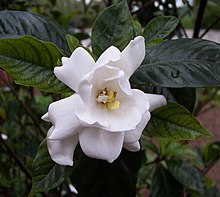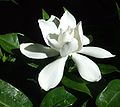Gardenia
| Gardenia | |
|---|---|

| |
| Gardenia jasminoides | |
| Scientific classification | |
| Kingdom: | Plantae |
| Clade: | Tracheophytes |
| Clade: | Angiosperms |
| Clade: | Eudicots |
| Clade: | Asterids |
| Order: | Gentianales |
| Family: | Rubiaceae |
| Subfamily: | Ixoroideae |
| Tribe: | Gardenieae |
| Genus: | Gardenia J.Ellis |
| Species | |
|
See text | |
Gardenia is a genus of flowering plants in the coffee family, Rubiaceae, native to the tropical and subtropical regions of Africa, Asia, Madagascar and Pacific Islands.[1]
The genus was named by Carl Linnaeus and John Ellis after Dr. Alexander Garden (1730-1791), a Scottish-born American naturalist.[2]
They are evergreen shrubs and small trees growing to 1–15 metres (3.3–49.2 ft) tall. The leaves are opposite or in whorls of three or four, 5–50 centimetres (2.0–19.7 in) long and 3–25 centimetres (1.2–9.8 in) broad, dark green and glossy with a leathery texture. The flowers are solitary or in small clusters, white, or pale yellow, with a tubular-based corolla with 5-12 lobes (petals) from 5–12 centimetres (2.0–4.7 in) diameter. Flowering is from about mid-spring to mid-summer, and many species are strongly scented.
Species
As of March 2014[update] The Plant List recognises 140 accepted species (including infraspecific names):[3]
- Gardenia actinocarpa Puttock
- Gardenia anapetes A.C.Sm.
- Gardenia angkorensis Pit.
- Gardenia annamensis Pit.
- Gardenia aqualla Stapf & Hutch.
- Gardenia archboldiana Merr. & L.M.Perry
- Gardenia artensis Montrouz.
- Gardenia aubryi Vieill.
- Gardenia barnesii Merr.
- Gardenia beamanii Y.W.Low
- Gardenia boninensis (Nakai) Tuyama ex T.Yamaz.
- Gardenia brachythamnus (K.Schum.) Launert
- Gardenia brighamii H.Mann - Nānū (Hawaiʻi)
- Gardenia buffalina (Lour.) Poir. in J.B.A.M.de Lamarck (= Genipa buffalina)
- Gardenia cambodiana Pit.
- Gardenia candida A.C.Sm.
- Gardenia carinata Wall. ex Roxb. India, Malaya.
- Gardenia carstensensis Wernham
- Gardenia chanii Y.W.Low
- Gardenia chevalieri Pit.
- Gardenia clemensiae Merr. & L.M.Perry
- Gardenia collinsae Craib
- Gardenia colnettiana Guillaumin
- Gardenia conferta Guillaumin
- Gardenia cornuta Hemsl. (Natal gardenia). South Africa.
- Gardenia coronaria Buch.-Ham.
- Gardenia costulata Ridl.
- Gardenia crameri Tirveng.
- Gardenia cuneata Kurz
- Gardenia dacryoides A.Cunn. ex Puttock
- Gardenia deplanchei Vieill. ex Guillaumin
- Gardenia dolichantha Merr.
- Gardenia elata Ridl.
- Gardenia epiphytica Jongkind
- Gardenia erubescens Stapf & Hutch.
- Gardenia esculenta Stokes
- Gardenia ewartii Puttock
- Gardenia faucicola Puttock
- Gardenia fiorii Chiov.
- Gardenia flava (Lour.) Poir. in J.B.A.M.de Lamarck (= Genipa flava)
- Gardenia forsteniana Miq.
- Gardenia fosbergii Tirveng.
- Gardenia fucata R.Br. ex Benth.
- Gardenia fusca Geddes
- Gardenia gardneri Puttock
- Gardenia gjellerupii Valeton
- Gardenia gordonii Baker
- Gardenia grandis Korth. - synonym of Ridsdalea grandis
- Gardenia grievei Horne ex Baker
- Gardenia griffithii Hook.f.
- Gardenia gummifera L.f. India. Small tree, to 3 m high.
- Gardenia hageniana Gilli
- Gardenia hainanensis Merr.
- Gardenia hansemannii K.Schum.
- Gardenia hillii Horne ex Baker
- Gardenia hutchinsoniana Turrill – Fiji
- Gardenia imperialis K.Schum. Tropical Africa. Small tree to 12 m.
- subsp. physophylla (K.Schum.) L.Pauwels
- Gardenia invaginata Merr. & L.M.Perry
- Gardenia ixorifolia R.Br. ex Hook.f.
- Gardenia jabiluka Puttock
- Gardenia jasminoides J.Ellis (Common gardenia, Cape jasmine or Cape jessamine). Southern China and Japan.
- Gardenia kakaduensis Puttock
- Gardenia kamialiensis Takeuchi
- Gardenia lacciflua K.Krause
- Gardenia lamingtonii F.M.Bailey
- Gardenia lanutoo Reinecke
- Gardenia latifolia Aiton India. Shrub or tree, 5–10 m high.
- Gardenia leopoldiana De Wild. & T.Durand
- Gardenia leschenaultii D.Dietr.
- Gardenia magnifica Geddes
- Gardenia mannii H.St.John & Kuykendall (Hawaiʻi)
- Gardenia maugaloae Lauterb.
- Gardenia megasperma F.Muell.
- Gardenia mollis Schltr.
- Gardenia moszkowskii Valeton
- Gardenia mutabilis Reinw. ex Blume
- Gardenia ngoyensis Schltr.
- Gardenia nitida Hook.
- Gardenia obtusifolia Roxb. ex Hook.f.
- Gardenia ornata K.M.Wong
- Gardenia oudiepe Vieill.
- Gardenia ovularis F.M.Bailey
- Gardenia pallens Merr. & L.M.Perry
- Gardenia panduriformis Pierre ex Pit.
- Gardenia papuana F.M.Bailey
- Gardenia philastrei Pierre ex Pit.
- Gardenia posoquerioides S.Moore
- Gardenia propinqua Lindl.
- Gardenia pseudoternifolia Valeton
- Gardenia psidioides Puttock
- Gardenia pterocalyx Valeton
- Gardenia pyriformis A.Cunn. ex Benth.
- subsp. keartlandii (Tate) Puttock
- Gardenia racemulosa Korth.
- Gardenia reinwardtiana Blume
- Gardenia remyi H.Mann (Hawaiʻi)
- Gardenia resinifera Roth (Brilliant gardenia, Cambi resin tree, or dikamali) India. Shrub or small tree, to 3 m high. (= G. lucida, Genipa resinifera)
- Gardenia resiniflua Hiern (Gummy grdenia). South Africa.
- Gardenia resinosa F.Muell.
- Gardenia rupicola Puttock
- Gardenia rutenbergiana (Baill. ex Vatke) J.-F.Leroy (= Genipa rutenbergiana)
- Gardenia saxatilis Geddes
- Gardenia scabrella Puttock far north Queensland- used in amenities plantings in Cairns
- Gardenia schlechteri Bonati & Petitm.
- Gardenia schwarzii Puttock
- Gardenia sericea Puttock
- Gardenia similis (Craib) Craib
- Gardenia siphonocalyx Valeton
- Gardenia sokotensis Hutch.
- Gardenia sootepensis Hutch.
- Gardenia stenophylla Merr.
- Gardenia stipulosa Zoll. & Moritzi
- Gardenia storckii Oliv.
- Gardenia subacaulis Stapf & Hutch.
- Gardenia subcarinata (Corner) Y.W.Low
- Gardenia succosa Baker
- Gardenia taitensis DC. (Tahitian gardenia, Tiare māori in Tahitian, tiale in Samoan). Polynesia.
- Gardenia tannaensis Guillaumin
- Gardenia ternifolia Schumach. & Thonn. (Large-leaved Transvaal gardenia). Sudano-Zambezian savannas and woodlands.
- var. goetzei (Stapf & Hutch.) Verdc.
- subsp. jovis-tonantis (Welw.) Verdc. (= G. jovis-tonantis, Genipa jovis-tonantis)
- Gardenia tessellaris Puttock
- Gardenia thailandica Tirveng.
- Gardenia thunbergia Thunb. (White gardenia, forest gardenia, or witkatjiepiering) South Africa. Shrub or small tree, 2–5 m high.
- Gardenia tinneae Kotschy & Heuglin
- Gardenia transvenulosa Verdc.
- Gardenia trochainii Sillans
- Gardenia tropidocarpa Wernham
- Gardenia truncata Craib
- Gardenia tubifera Wall. ex Roxb. (Golden gardenia). Southeastern Asia. Small tree to 15 m high.
- Gardenia urvillei Montrouz.
- Gardenia vernicosa Merr. & L.M.Perry
- Gardenia vilhelmii Domin
- Gardenia vitiensis Seem. (Fijian gardenia) Fiji.
- Gardenia vogelii Hook.f.
- Gardenia volkensii K.Schum. (Transvaal gardenia or savanna gardenia). Tropical Africa.
- var. saundersiae (N.E.Br.) Verdc.
- subsp. spathulifolia (Stapf & Hutch.) Verdc.
- Gardenia vulcanica K.M.Wong
Cultivation and uses
Gardenia plants are prized for the strong sweet scent of their flowers, which can be very large in size in some species.
Gardenia jasminoides (syn. G. grandiflora, G. Florida) is cultivated as a house plant. This species can be difficult to grow because it originated in warm humid tropical areas. It demands high humidity to thrive, and bright (not direct) light. It flourishes in acidic soils with good drainage and thrives on [68-74 F temperatures (20-23 C)][4] during the day and 60 F (15-16 C) in the evening. Potting soils developed especially for gardenias are available. G. jasminoides grows no larger than 18 inches in height and width when grown indoors. In climates where it can be grown outdoors, it can attain a height of 6 feet. If water touches the flowers, they will turn brown.[5]
In China and Japan, Gardenia jasminoides is called zhīzi (栀子) and kuchinashi (梔), respectively. Its fruit is used as a yellow dye,[6] used on fabric and food (including the Korean mung bean jelly called hwangpomuk). Its fruits are also used in traditional Chinese medicine for their clearing, calming, and cooling properties.[7]
In France, gardenias are the flower traditionally worn by men as boutonnière when in evening dress. In The Age of Innocence, Edith Wharton suggests it was customary for upper-class men from New York City to wear a gardenia in their buttonhole during the Gilded Age.[8]
Sigmund Freud remarked to the poet H.D. that gardenias were his favorite flower.[9]
Several species occur in Hawaii, where gardenias are known as naʻu or nānū.
Crocetin is a chemical compound usually obtained from Crocus sativus, which can also be obtained from the fruit of Gardenia jasminoides.[10]
Hattie McDaniel famously wore gardenias in her hair when she accepted an Academy Award, the first for an African American, for Gone With The Wind. Mo'Nique Hicks later wore gardenias in her hair when she won her Oscar as a tribute to McDaniels.
Gallery
-
Gardenia brighamii
-
Gardenia jasminoides 'Plena'
-
Gardenia jasminoidesl 'Radicans'
-
Gardenia psidioides
-
Gardenia taitensis
-
Gardenia thunbergia by Edith Struben (1868-1936) -
Gardenia volkensii flower
-
Gardenia volkensii flowers, foliage, fruit
-
Blooming stages of gardenia flower (1 of 6)
-
Blooming stages of gardenia flower (2 of 6)
-
Blooming stages of gardenia flower (3 of 6)
-
Blooming stages of gardenia flower (4 of 6)
-
Blooming stages of gardenia flower (5 of 6)
-
Blooming stages of gardenia flower (6 of 6)
References
- ^ Tao Chen; Charlotte M. Taylor, "Gardenia J. Ellis, Philos. Trans. 51: 935. 1761", Flora of China online, vol. 19
- ^ Ellis, John (1759). [1] "An Account of the Plants Halesia and Gardenia: In a Letter from John Ellis, Esq; F. R. S. to Philip Carteret Webb, Esq; F. R. S." Phil Trans R Soc 1759 51: 929-935.
- ^ "Gardenia". The Plant List. Retrieved 2014-03-06.
- ^ http://www.uri.edu/ce/factsheets/sheets/gardenia.html
- ^ Reader's Digest. Success with House Plants. The Reader's Digest Association, Inc. New York/Montreal. 217
- ^ Ozaki, A.; Kitano, M.; Furusawa, N.; Yamaguchi, H.; Kuroda, K.; Endo, G. (2002), "Genotoxicity of gardenia yellow and its components", Food and Chemical Toxicology, 40 (11): 1603–1610, doi:10.1016/S0278-6915(02)00118-7
- ^ http://www.sacredlotus.com/herbs/get.cfm/chinese_herb/zhi_zi_gardenia_cape_jasmine_fruit
- ^ Edith Wharton, The Age of Innocence, Wordsworth Classic, 1999, p. 4
- ^ H.D. (Hilda Doolittle). "Tribute to Freud." New Directions, Boston 1974 p11
- ^ Yamauchi, M; Tsuruma, K; Imai, S; Nakanishi, T; Umigai, N; Shimazawa, M; Hara, H (2011). "Crocetin prevents retinal degeneration induced by oxidative and endoplasmic reticulum stresses via inhibition of caspase activity". European Journal of Pharmacology. 650 (1): 110–9. doi:10.1016/j.ejphar.2010.09.081. PMID 20951131.














